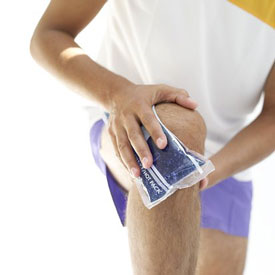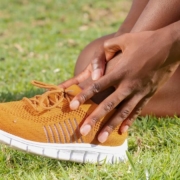Patellofemoral Pain Syndrome a.k.a Runner’s Knee
 Runner’s knee or patellofemoral pain syndrome is a common biomechanical problem that can affect anyone who is involved in activities that requires on-going knee bending, such as walking, biking, or running.
Runner’s knee or patellofemoral pain syndrome is a common biomechanical problem that can affect anyone who is involved in activities that requires on-going knee bending, such as walking, biking, or running.
Patellofemoral pain syndrome can result from:
- Overuse. Repeated overstretching of the muscles and tendons of the knee
- Trauma to the knee by a fall or blow
- Misalignment. If any of the bones are slightly misaligned excessive stress is placed on the cartilage of the kneecap.
- Worn cartilage in the knee joint
- Leg length discrepancies
- If you suffer from over pronation, fallen arches or high arches
Minor to moderate cases of runner’s knee should heal with minimum treatment and minimal down time.
- Rest the knee. Try to avoid putting weight on your knee for a few days
- Ice your knee to reduce pain and swelling. Do this for 20-30 minutes every 3-4 hours for 2-3 days
- Compress your knee by using an elastic bandage, athletic tape, or a soft brace
- Elevate your knee whenever you’re sitting or lying down
- Use anti-inflammatory medication
- Practice stretching and strengthening exercises
- Use orthotics to support your arches
Chiropractic and Physiotherapy can treat runner’s knee with manual manipulations and modalities to get you back to your regular routine as quickly as possible.
- Deep Tissue Laser Therapy – accelerates the body’s own natural healing process
- Graston Technique – soft tissue treatment that breaks down scar tissue
- Therapeutic Ultrasound – increases circulation to help the healing process and decreases pain.
- K-Taping – designed for muscle, ligament and tendon pain relief and support
- TENS Therapy – a non-invasive nerve stimulation intended to reduce both acute and chronic pain
- Shockwave Therapy – a non-surgical treatment of soft tissue, bone, and joint pain
How to prevent runner’s knee:
- Use custom orthotics in all your footwear
- Wear runners with good shock absorption and quality construction, and replace them often
- Avoid running on surfaces like concrete or asphalt
- Stay in shape and maintain a healthy weight
- Weak thigh muscles, tight hamstring and calf muscles can put extra stress on the knee; so stretch, stretch, stretch
- Tape your knee while exercising, if you’ve had runner’s knee before.
As with any injury, contact your doctor or health care practitioner to be diagnosed and to create a treatment plan that’s right for you.




